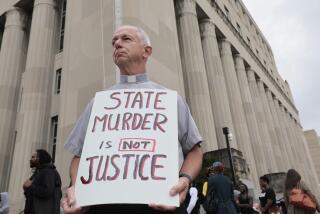Wounds Deep 10 Years After Nation’s Largest Death Row Escape : Virginia: Breakout of six condemned men, all of whom were recaptured, still haunts Mecklenburg Correctional Center, though employees rarely mention it.
BOYDTON, Va. — These days, Prince A. Thomas Jr. patrols the 20-foot fences surrounding the Mecklenburg Correctional Center. He has little contact with Death Row or its inmates.
“I don’t like to go over there,” he said.
Small wonder. Ten years ago, on May 31, 1984, Thomas was among 14 prison employees who were taken hostage by a determined band of six condemned men. The hostages were stripped, bound and locked in a cell.
The six, sentenced to die for a total of nine murders, then drove through the open gates of Virginia’s most secure prison. It was the largest Death Row escape in American history.
All were recaptured within three weeks; five of the six have been executed. The breakout still haunts Mecklenburg, though employees rarely mention it.
“You don’t ever get over it,” said Thomas.
“You can’t take nothing for granted. The only reason you walk out of here every day is because the inmates let you walk out. . . . I’m very aware of that.”
The escape was carefully planned, craftily prepared. The inmates had secreted homemade knives in cracks in their cell walls, then painted over the cracks. For months they listened to the guards’ conversations over an intercom, noting assignments, names and shift changes.
The Briley brothers--James and Linwood--were the masterminds; they had been accused of 11 murders in Richmond, although they were not tried for all of them. “You can’t burn a guy but one time,” the city prosecutor said after both Brileys were sentenced to death.
Richmond Circuit Judge James Wilkinson called the brothers’ crimes the “vilest rampage of rape, murder and robbery the court has seen in 30 years.”
The others: Derick L. Peterson, 22, killer of a supermarket worker; Willie Leroy Jones, 26, who robbed and killed an elderly couple; Lem D. Tuggle, 32, convicted of killing a woman; Earl Clanton Jr., 29, who strangled a librarian.
No one noticed when, after an evening recreation period, Clanton hid in a bathroom instead of returning to his cell. About 8:30, Clanton emerged and overpowered a lone guard in the cellblock’s control room.
He released the others, and for more than 90 minutes the group held the building hostage.
No one outside the building knew anything was amiss. About 10:30, the group forced a hostage to radio an emergency call. There was a bomb on Death Row and the guard would need a prison van immediately to remove it, the guard said.
The six donned riot gear and ran from the building, pretending to douse the bogus bomb with fire extinguishers. They jumped into the waiting van and disappeared into the hot, late spring night. It was close to a half-hour later when prison officials discovered the ruse.
“It was a freak happening,” said Jerry Davis, records manager at the prison. He is one of only a few senior prison officials who remain--most were transferred after the escape.
“They walked out; they did not break out. You have to remember that. It took human error for them to escape,” Davis said.
The escape terrified prison employees and residents of this rural tobacco-farming area near the North Carolina line, where the prison represents welcome employment but also makes an unsettling neighbor.
“I was afraid to even go out of my house,” said prison operations officer Joanne Royster, who was an inmate counselor at the time of the escape. “I would park my car right next to the door so I could run right out of the house. Everyone was scared.”
Clanton and Peterson were caught the next day in Warrenton, N.C.; Jones and Tuggle a week later, in Stanford, Vt., after Tuggle robbed a gift shop.
The Brileys were last. It took hundreds of law enforcement officials from several states, aided by a bounty hunter, three weeks to track the pair down.
When FBI agents closed in on June 19, the Brileys were calmly barbecuing chicken in Philadelphia.
Both were executed within a year, and the others soon followed. The sole survivor, Tuggle, declined to be interviewed; on June 8, a judge overturned his conviction and ordered that the state release him or retry him.
The breakout prompted a state investigation, which found that Mecklenburg, which was touted as state-of-the-art and virtually escape-proof when it opened eight years earlier, was actually vulnerable to escape because of weak security procedures and poorly trained employees.
“It was terribly embarrassing,” said Carl K. Hester, assistant warden at Mecklenburg Correctional Center. “We have done all we could to ensure nothing like that ever happened again.”
New security officers were hired. There are daily checks of the cell windows on Death Row, and the evening recreation period was eliminated.
A new wall with another locked door was added to the three cellblocks that make up Death Row. Individual guards no longer control all the locks and can lock themselves into their stations for protection.
“Obviously, after an incident like that, there were changes,” Hester said.
More to Read
Sign up for Essential California
The most important California stories and recommendations in your inbox every morning.
You may occasionally receive promotional content from the Los Angeles Times.










